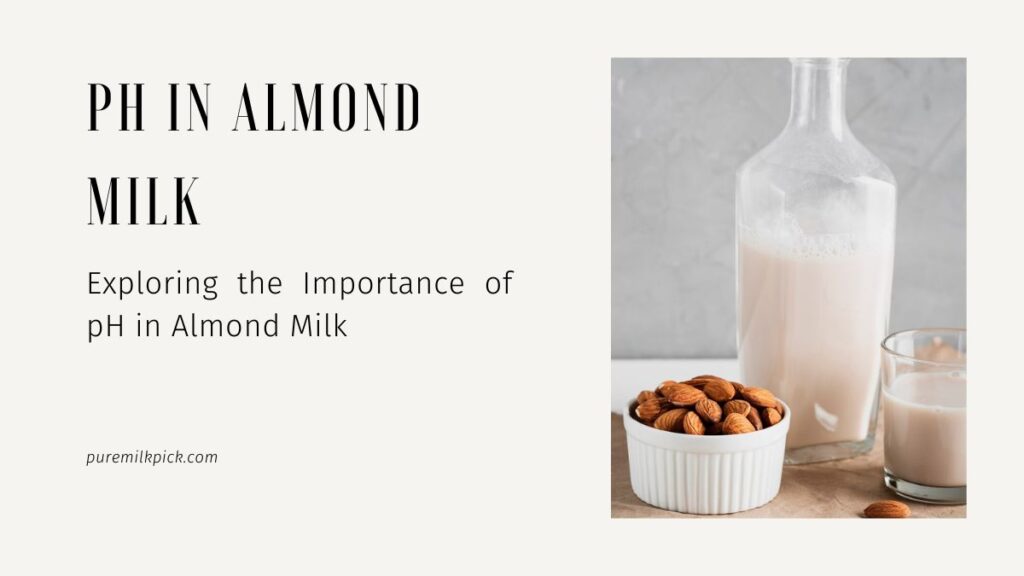Welcome, dear readers, to a journey into the heart of the almond, a beloved nut cherished for its taste and nutritional benefits. While almonds are celebrated for their crunchy texture and versatile use in various dishes, there’s a hidden aspect that often goes unnoticed – their pH level. In this blog post, we’ll unravel the mysteries surrounding the pH of almonds, exploring its implications on taste, health, and culinary applications. Get ready to dive deep into the world of almonds and discover how their pH might be the key to unlocking a healthier, tastier culinary experience.
What is pH?
pH Defined
Let’s kick off our exploration by understanding the term pH. pH measures the acidity or alkalinity of a substance on a scale from 0 to 14, with 7 being neutral. Anything below 7 is considered acidic, while values above 7 are alkaline. This scale is crucial in determining the fundamental nature of various substances, including the food we consume.
Significance in Food
In gastronomy, pH plays a pivotal role in shaping taste and texture. Acidity gives foods a sharp, tangy flavor, while alkalinity imparts a more subtle, rounded taste. The balance between these elements influences not only the culinary experience but also the nutritional impact of what we eat.
Read More: Unlocking the Power of Fortified Milk Meaning A Complete Guide
pH in the Context of Food
Understanding pH in the context of food is akin to deciphering a culinary code. It’s the secret language that influences the way our taste buds perceive flavors. The acidity or alkalinity of a dish can make or break its palatability, and that holds for almonds as well.
The pH of Almonds
pH Range of Raw Almonds
Almonds, in their raw form, exhibit a specific pH range. This range is influenced by a variety of factors, starting from the conditions in which the almond tree grows to the processes involved in harvesting and post-harvest handling. Typically, raw almonds fall within a specific pH spectrum that determines their taste and overall composition.
Factors Influencing Almond pH
To comprehend the pH of almonds, one must consider the intricacies of their cultivation. Soil composition, climate, and harvesting methods are key factors influencing the pH of almonds. The environment in which almonds grow shapes their chemical composition, thereby affecting their pH.
Harvesting and Processing Methods
The journey of almonds from the orchard to your plate involves multiple stages. Harvesting and processing methods can impact the pH of almonds. Whether they are raw or undergo various processes such as blanching or roasting, these methods contribute to the final pH profile of the almonds we consume.

Why Does pH Matter in Almonds?
Influence on Taste and Flavor
The pH of almonds directly influences their taste and flavor profile. Almonds with a slightly acidic pH might have a more pronounced nuttiness, while those with an alkaline pH could offer a smoother, milder taste. Understanding this interplay is essential for chefs, home cooks, and anyone passionate about culinary excellence.
Impact on Digestive Health
Beyond the realm of taste, almond pH also holds significance for digestive health. The alkaline nature of almonds may contribute to maintaining a balanced pH level within the body. As we delve into the health implications, it becomes clear that the pH of almonds is not just a culinary curiosity but a factor that can positively impact our well-being.
Role in Food Preservation and Storage
pH isn’t only about taste; it also plays a vital role in food preservation. Knowing the pH of almonds can guide storage practices. Understanding how acidity or alkalinity influences the shelf life of almond-based products helps consumers make informed choices, ensuring freshness and quality.
Almonds and the Body’s pH Balance
Overview of the Body’s pH Regulation
Before we explore how almonds interact with the body’s pH, let’s take a moment to understand the body’s pH regulation. The human body tightly regulates its pH to maintain optimal function. From blood to digestive fluids, various bodily systems work in harmony to ensure a balanced pH environment.
How Almonds Interact with the Body
Almonds, with their specific pH, interact with the body in intriguing ways. As an alkaline-forming food, they may contribute to the body’s overall alkalinity. Some believe this alkaline state supports health and well-being, making almonds not just a tasty snack but a potential ally in maintaining a balanced internal environment.
Almonds as Alkaline-Forming Foods
The concept of alkaline-forming foods suggests that certain foods, including almonds, can help counteract the naturally acidic state of the body. While scientific opinions on this topic may vary, it adds an extra layer of interest to the exploration of almonds beyond their culinary appeal.

pH Testing Methods for Almonds
Laboratory Testing Procedures
For those curious about the exact pH of almonds, laboratory testing procedures offer precise measurements. These tests involve specialized equipment and expert analysis to provide accurate pH readings. Understanding these procedures provides insight into the science behind determining the pH of almonds.
pH Testing Kits for Home Use
For the more hands-on enthusiasts, pH testing kits designed for home use are available. These kits allow individuals to explore the pH of almonds in their kitchen. While not as precise as laboratory methods, these kits offer a practical way for home cooks to experiment and gain a basic understanding of the pH spectrum in their favorite nuts.
Understanding pH Labels on Almond Products
As consumers, navigating the aisles of grocery stores presents us with an array of almond products. Understanding the pH labels on almond butter, almond milk, and other products is crucial for making informed choices. Manufacturers often provide this information, giving consumers insights into the acidity or alkalinity of the almond-based products they purchase.

Almonds in Culinary Applications
pH Considerations in Almond-Based Recipes
For chefs and home cooks alike, the pH of almonds becomes a critical consideration when crafting recipes. Whether preparing a savory almond-crusted dish or a sweet almond-flour dessert, understanding how almond pH interacts with other ingredients is key to achieving the desired taste and texture.
Almond Products and Their pH Levels
Different almond products, from almond butter to almond milk, may exhibit varying pH levels. Exploring these variations opens up a world of culinary possibilities. Almond products with distinct pH profiles can be paired thoughtfully with other ingredients, enhancing the overall gastronomic experience.
Tips for Maintaining Optimal pH
Maintaining optimal pH during cooking is an art. Certain cooking techniques and ingredient combinations can be employed for those seeking to preserve the natural pH of almonds in their dishes. These tips ensure that the unique taste and potential health benefits associated with almond pH are preserved.
Conclusion
In conclusion, the pH of almonds is more than just a scientific curiosity; it’s a key factor shaping our culinary experiences and potentially impacting our well-being. As you savor your next almond snack or incorporate almond-based products into your recipes, consider the pH as a hidden element that adds depth to the flavor and potentially contributes to a balanced internal environment. Stay curious, experiment in the kitchen, and let the pH of almonds be your guide to a tastier, healthier culinary journey.
FAQs about Almond pH
While opinions vary, some believe that alkaline-forming foods, like almonds, can contribute to a balanced internal pH, potentially supporting overall health.
Yes, almond products like almond butter and almond milk can have varying pH levels. Checking pH labels on these products helps consumers choose according to their taste preferences and culinary needs.
The pH of almonds influences their taste, flavor, and potential health benefits. Understanding it allows consumers and chefs to make informed choices for a better culinary experience.



